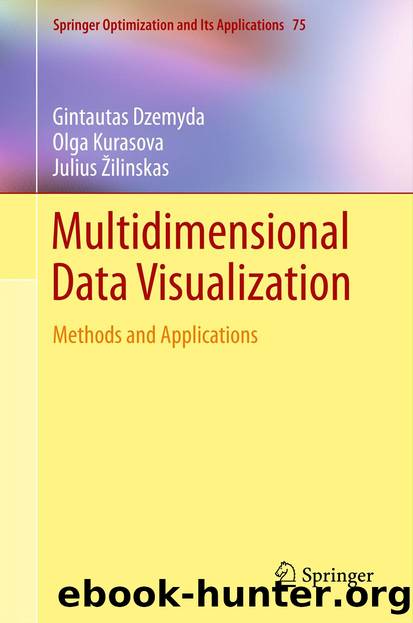Multidimensional Data Visualization by Gintautas Dzemyda Olga Kurasova & Julius Žilinskas

Author:Gintautas Dzemyda, Olga Kurasova & Julius Žilinskas
Language: eng
Format: epub
Publisher: Springer New York, New York, NY
After training the network, the remaining 30 points (10 of each species) are presented to the trained network, and their two-dimensional projections are obtained at the output of the network. The visualization results are presented in Fig. 4.6: Setosa—dark blue, Versicolor—dark red, and Virginica—dark green. Here, we see that the points unseen by the network have found proper places.
4.1.3.2 Auto-Associative Neural Network
An auto-associative feed-forward neural network [4, 124] allows the dimensionality reduction by taking the output values of all d neurons in the hidden, so-called bottleneck layer, where d is chosen equal to the dimensionality of a low-dimensional space. The n-dimensional training data are presented to both input and output layers to obtain a reduced d-dimensional representation in the bottleneck layer. So, this network is trained in an unsupervised way.
The auto-associative feed-forward neural network is often called as an auto- encoder network [38, 92]. It is a nonlinear generalization of the principal component analysis that uses an adaptive, multilayer encoder network to transform the multidimensional data into the low-dimensional space and a similar decoder network to recover the data from the low-dimensionality. It is discovered in [92] that the nonlinear auto-encoders work considerably better as compared to the widely used methods such as the principal component analysis or locally linear embedding.
An auto-associative feed-forward neural network consists of two parts: The first part transforms the initial multidimensional data to a low-dimensional space (mapping layer).
Download
This site does not store any files on its server. We only index and link to content provided by other sites. Please contact the content providers to delete copyright contents if any and email us, we'll remove relevant links or contents immediately.
Algorithms of the Intelligent Web by Haralambos Marmanis;Dmitry Babenko(8519)
Test-Driven Development with Java by Alan Mellor(7351)
Data Augmentation with Python by Duc Haba(7252)
Principles of Data Fabric by Sonia Mezzetta(6995)
Learn Blender Simulations the Right Way by Stephen Pearson(6931)
Microservices with Spring Boot 3 and Spring Cloud by Magnus Larsson(6762)
RPA Solution Architect's Handbook by Sachin Sahgal(6167)
Hadoop in Practice by Alex Holmes(6028)
Jquery UI in Action : Master the concepts Of Jquery UI: A Step By Step Approach by ANMOL GOYAL(5869)
The Infinite Retina by Robert Scoble Irena Cronin(5869)
Big Data Analysis with Python by Ivan Marin(5693)
Life 3.0: Being Human in the Age of Artificial Intelligence by Tegmark Max(5398)
Pretrain Vision and Large Language Models in Python by Emily Webber(4653)
Infrastructure as Code for Beginners by Russ McKendrick(4438)
WordPress Plugin Development Cookbook by Yannick Lefebvre(4168)
Functional Programming in JavaScript by Mantyla Dan(4121)
The Age of Surveillance Capitalism by Shoshana Zuboff(4111)
Embracing Microservices Design by Ovais Mehboob Ahmed Khan Nabil Siddiqui and Timothy Oleson(3957)
Applied Machine Learning for Healthcare and Life Sciences Using AWS by Ujjwal Ratan(3930)
